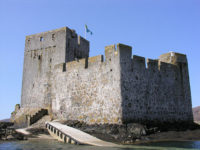 Kisimul Castle Kisimul Castle, the seat of the chief of the Macneils of Barra, tells us of the nature of Gaelic lordship in the Middle Ages. Caisteal Chiosmuil, the island stronghold’s Gaelic name, means ‘castle of the rock of the small bay’.
Kisimul Castle Kisimul Castle, the seat of the chief of the Macneils of Barra, tells us of the nature of Gaelic lordship in the Middle Ages. Caisteal Chiosmuil, the island stronghold’s Gaelic name, means ‘castle of the rock of the small bay’.
The Castle is built on a rocky islet in the bay, just off the coast of Barra. It can only be reached by boat. Legend has it that was the stronghold of the MacNeils since the 11th century.
The castle built in the 1400s was originally a three-storey tower house, in which the clan chief lived. A curtain wall fringed the small rock on which Kisimul stood, and enclosed the small courtyard with its ancillary buildings.
Ancillary buildings included a:
feasting hall
chapel
tanist’s (heir’s) house
gokman’s (watchman’s) house
A well near the postern gate is fed with fresh water from an underground seam. Outside the curtain wall, beside the original landing-place, are the foundations of the crew house, where the sailors
manning their chief’s galley had their quarters.
Kisimul was abandoned in 1838 when the island was sold, and the castle’s condition subsequently deteriorated. Some of its stone was used as ballast for fishing vessels, and some even ended up as paving in Glasgow. The remains of the castle, along with most of the island of Barra, were purchased in 1937 by Robert Lister MacNeil, a
descendant of the 22nd chief and the then chief of Clan MacNeil, and spent his life restoring Kisimul Castle.
In 2001, the castle was leased by the chief of Clan MacNeil to Historic Scotland for 1000 years for the annual sum of £1 and a bottle of whisky. For the 2011 census, the island was classified by the
National Records of Scotland as an inhabited island that “had no usual residents at the time of either the 2001 or 2011 censuses.
Plaques in the Castle


Kimisul Castle, Historic Environment of Scotland
Historic Scotland-Kisimul Castle Monument Update
A Castle on the Sea: Details on Kisimul Castle, Barra Abstract by
Society of Antiquaries of Scotland
